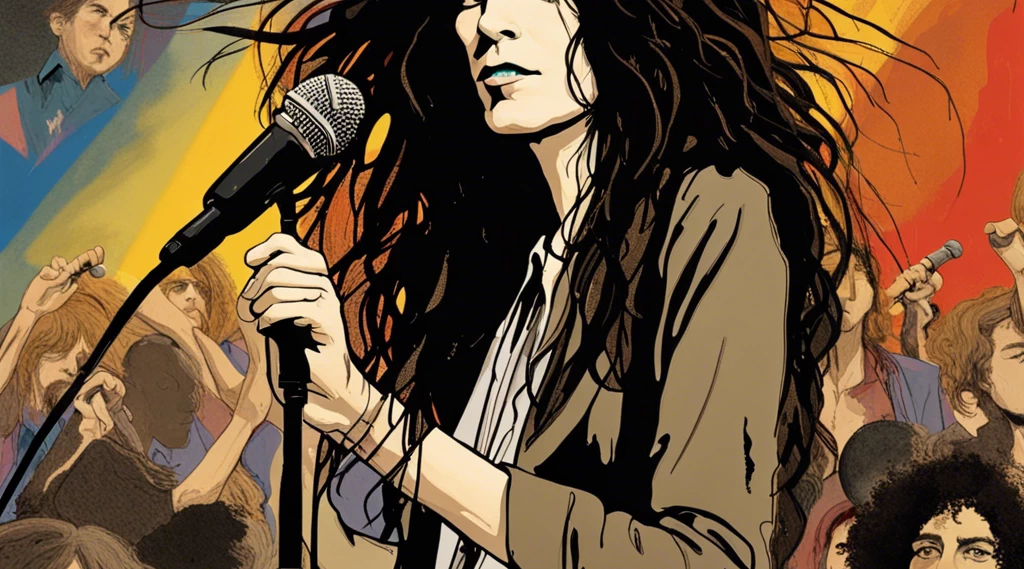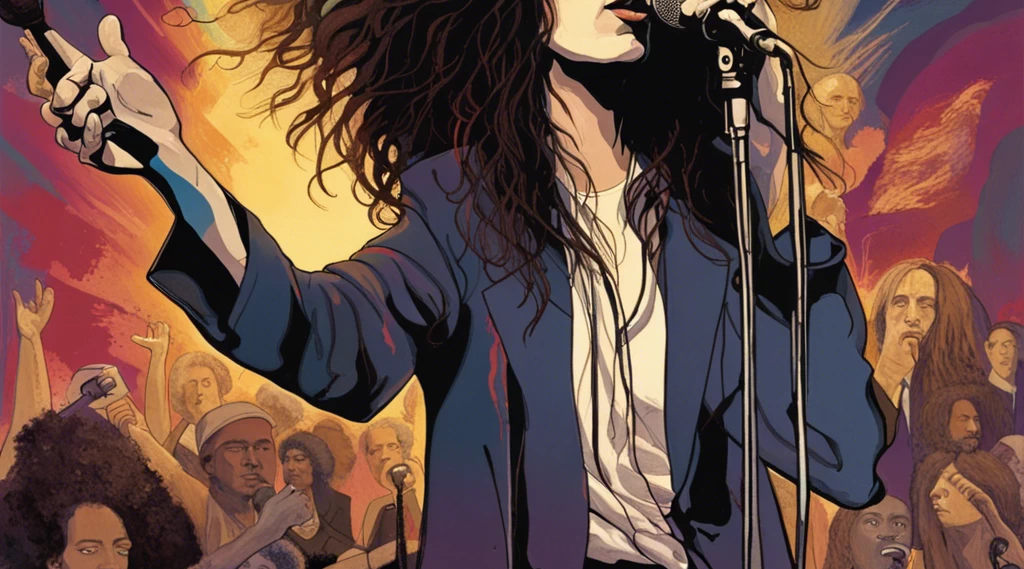In “Just Kids,” Patti Smith, the iconic singer-songwriter and artist, takes us on a captivating journey through her formative years in New York City during the late 1960s and 1970s. This memoir offers a poignant and intimate glimpse into her unique bond with the legendary photographer Robert Mapplethorpe, their artistic pursuits, and the vibrant bohemian counterculture that fueled their creative spirits.
Patti Smith’s indelible mark on the music and art world is unmistakable. With a career spanning over five decades, she has been a trailblazer, pioneer, and influential figure whose work transcends genres and defies conventions. Known for her poetic lyrics and raw performances, Smith’s ability to merge poetry, music, and visual art has earned her numerous accolades and an enduring legacy.
In “Just Kids,” Smith delves into her early years as a struggling artist and poet, navigating the gritty streets of New York City’s cultural epicenter, specifically the Chelsea Hotel—a hub for aspiring artists and intellectuals. Her narrative intertwines with the life and artistry of Robert Mapplethorpe, forming a deep bond of love, friendship, and shared dreams as they support and inspire each other’s artistic pursuits.
With eloquence and heartfelt honesty, Smith recounts their experiences, relationships, and personal struggles as they navigate the vibrant but often challenging art scene. She paints a vivid picture of the people, places, and moments that shaped their lives, offering readers a glimpse into the soul of the emerging artist and the transformative power of artistic expression.
In this summary, we will delve into the world of “Just Kids,” exploring Patti Smith’s evocative storytelling and the profound connection between her and Robert Mapplethorpe. We will witness their artistic evolution, the challenges they faced, and the indomitable spirit that propelled them forward. Through this exploration, we aim to understand the enduring impact of their artistic collaboration and the inspirational journey that molded Smith into the influential artist she is today.
Here you can read an interview with Patti Smith about her book “Just Kids”.
Chapter 1: Childhood and Early Aspirations
In this chapter, Smith delves into her childhood and upbringing in New Jersey. She shares her early love for art, poetry, and music, which would go on to shape her future as an artist.
Smith describes her childhood as a time of imagination and creativity. She had a deep fascination with books, spending hours at the library exploring different worlds and ideas. From a young age, she was drawn to the beauty of words and the power of storytelling.
Growing up in a modest family, Smith’s love for art was nurtured by her mother, who encouraged her artistic pursuits. She recalls painting pictures and making collages using materials she found around the house. These early experiences sparked her desire to express herself through visual mediums.
Smith also reveals her passion for music, particularly rock and roll. She remembers listening to radio broadcasts and becoming captivated by the sounds and energy of bands like Elvis Presley and Little Richard. The raw emotion and rebellion embodied in rock and roll fascinated her, and she dreamed of someday being part of that world.
As a teenager, Smith felt a strong pull towards New York City, viewing it as a vibrant hub of creativity and possibility. She yearned to escape the confines of small-town life and immerse herself in the city’s artistic scene. Her aspirations were fueled by the likes of Bob Dylan, Arthur Rimbaud, and William Blake, whose works resonated deeply with her.
In this chapter, Smith lays the foundation for her journey as an artist, highlighting the importance of her formative years and the early influences that shaped her creative spirit. It sets the stage for the subsequent chapters, where she explores her experiences in New York City and the friendships she forms with other artists, musicians, and writers.
Chapter 2: Arrival in New York City
Chapter 2 of the book “Just Kids” by Patti Smith is titled “Arrival in New York City.” In this chapter, Smith recounts her arrival in New York City and the initial struggles she faced as a young artist. She vividly portrays the city’s vibrant artistic scene and her determination to find her own voice amidst the bustling metropolis.
Smith describes her first impressions of New York City, emphasizing its vastness and energy. She immediately feels a sense of belonging and is inspired by the creative atmosphere surrounding her. She encounters other artists and musicians who share her passion for self-expression, and their presence fuels her aspirations.
The chapter focuses on Smith’s early struggles to establish herself as an artist. She faces financial difficulties and lives in poverty, often relying on meager meals and the generosity of others. Despite these challenges, she remains steadfast in her commitment to her art, finding solace in the pursuit of her creative vision.
Smith immerses herself in the cultural life of New York City, attending poetry readings, art exhibitions, and musical performances. She encounters influential figures within the artistic community and is exposed to new ideas and artistic expressions. These experiences shape her perspective and deepen her understanding of her own artistic path.
Throughout the chapter, Smith’s determination to find her own voice shines through. She explores different artistic mediums, experiments with various forms of expression, and begins writing her own poetry. She embraces the bohemian lifestyle and actively seeks out opportunities to showcase her work and collaborate with other artists.
“Arrival in New York City” sets the stage for the transformative journey that lies ahead for Patti Smith. It captures the excitement, hardships, and endless possibilities of being a young artist in New York City during the 1960s. Through her storytelling, Smith paints a vivid picture of the city’s artistic landscape and reveals her unwavering drive to make her mark in the world of art and music.
Chapter 3: Meeting Robert Mapplethorpe
In this chapter, Smith recounts the fateful encounter that would shape her life and artistic journey – her meeting with the renowned photographer Robert Mapplethorpe. Their connection and shared artistic ideals form the foundation of a profound and enduring bond.
Smith vividly describes the circumstances surrounding their meeting. It takes place in New York City at a time when both Smith and Mapplethorpe are struggling artists trying to find their place in the world. Their initial encounter is marked by a sense of recognition and an instant connection that transcends words.
As Smith delves into Mapplethorpe’s background, she reveals his own artistic aspirations and personal struggles. They both come from backgrounds marked by hardship, which deepens their understanding and empathy for one another. Their shared experiences create a strong emotional bond, and they quickly become inseparable companions and confidants.
Smith and Mapplethorpe embark on a journey together, navigating the challenges of artistry, love, and self-discovery. They support each other through times of poverty, rejection, and self-doubt, providing solace and encouragement. They engage in intense discussions about art, philosophy, and the meaning of creativity, shaping each other’s perspectives along the way.
The chapter showcases the unique dynamic of their relationship, characterized by a deep sense of mutual respect, admiration, and collaboration. Smith recognizes Mapplethorpe’s talent as a visual artist and encourages him to pursue photography seriously. Meanwhile, Mapplethorpe views Smith’s poetic voice as something to be cherished and nurtured.
“Meeting Robert Mapplethorpe” captures the profound impact of this encounter on both Smith and Mapplethorpe’s lives and artistic journeys. Their shared dreams, struggles, and unwavering support for one another lay the groundwork for their future endeavors. Together, they navigate the challenges and triumphs of the vibrant New York City art scene, leaving an indelible mark on each other’s lives and the world of art.
Chapter 4: Struggles and Creative Growth
Chapter 4 of the book “Just Kids” by Patti Smith is titled “Struggles and Creative Growth.” In this chapter, Smith delves into the challenges she and Robert Mapplethorpe faced as struggling artists in New York City. Despite their financial hardships, they remain dedicated to their artistic pursuits and experience significant growth in their creative journeys.
Smith vividly portrays the poverty and difficult living conditions they endure during this period. They face constant uncertainty and struggle to make ends meet, often relying on the kindness of friends and acquaintances for shelter and sustenance. However, their shared passion for art serves as a source of inspiration and resilience.
Despite the challenges, Smith and Mapplethorpe continue to develop their artistic voices. Smith emphasizes the importance of experimentation and risk-taking in their work. They explore different mediums, themes, and artistic techniques, pushing boundaries and challenging societal norms.
Smith describes how they immerse themselves in the vibrant artistic scene of New York City, attending gallery openings, poetry readings, and music performances. They encounter influential figures such as Allen Ginsberg, Sam Shepard, and Andy Warhol, who inspire them and provide valuable insights into the creative process.
Throughout the chapter, Smith highlights the role of collaboration and community in their artistic growth. She reflects on the friendships they form with other budding artists, poets, and musicians who become part of their creative circle. These relationships foster a supportive environment that nurtures and challenges their artistic visions.
As the chapter progresses, Smith and Mapplethorpe begin to gain recognition for their work. They participate in exhibitions, poetry readings, and performance art events. Their dedication and perseverance start to pay off, as they receive validation and feedback from both peers and established members of the art world.
“Struggles and Creative Growth” captures the resilience, determination, and artistic evolution of Smith and Mapplethorpe. It showcases their unwavering commitment to their craft, despite the financial hardships they face. Through their shared experiences and collaborations, they continue to refine their artistic voices and pave the way for the remarkable careers that lie ahead.

Chapter 5: The Chelsea Hotel
In this chapter, Smith delves into her and Robert Mapplethorpe’s move to the iconic Chelsea Hotel in New York City. The hotel becomes a hub for artists, musicians, and writers, providing an atmosphere that nurtures their creativity and shapes their artistic endeavors.
Smith vividly portrays the unique environment of the Chelsea Hotel, with its eclectic mix of residents from various artistic disciplines. She describes the physical space, the vibrant energy, and the sense of camaraderie that permeates the building. The hotel serves as a haven for bohemian souls seeking inspiration and connection.
Living in the Chelsea Hotel exposes Smith and Mapplethorpe to a diverse range of artists and intellectuals. They encounter figures such as Janis Joplin, Jimi Hendrix, William S. Burroughs, and Allen Ginsberg, among many others. These encounters provide invaluable opportunities for collaboration, mentorship, and the exchange of ideas.
The chapter explores the impact of the Chelsea Hotel on Smith and Mapplethorpe’s creative processes. The unique atmosphere inspires experimentation and pushes artistic boundaries. Smith immerses herself in writing poetry and lyrics, while Mapplethorpe continues to hone his photography skills, capturing portraits that reflect his evolving vision.
Smith emphasizes the importance of the friendships and relationships formed within the Chelsea Hotel community. These connections extend beyond mere social interactions; they become integral to the development of their artistry. Smith and Mapplethorpe find kindred spirits who understand their struggles, support their ambitions, and offer constructive criticism.
As the chapter progresses, Smith reflects on the transient nature of life at the Chelsea Hotel. Residents come and go, and the creative ecosystem constantly evolves. However, the impact of those formative years spent within its walls lingers on, shaping their artistic trajectories and leaving an indelible mark on their lives.
“The Chelsea Hotel” captures the essence of this iconic artistic enclave and its significance in Smith and Mapplethorpe’s lives. It highlights the power of community, collaboration, and inspiration found within its walls. The chapter serves as a testament to the transformative influence of physical spaces on creativity and the lasting bonds forged among artists.
Chapter 6: Artistic Success and Personal Loss
Smith explores the blossoming of her and Robert Mapplethorpe’s artistic careers in Chapter 6, along with the personal challenges and losses they face along the way.
Smith begins by depicting their emergence into the New York art scene. Both she and Mapplethorpe experience increasing recognition for their work. Smith finds success as a musician, performing in various venues and releasing albums. Meanwhile, Mapplethorpe gains acclaim for his provocative photography, which challenges societal norms and pushes artistic boundaries.
Amidst their growing success, Smith captures the personal struggles they face. Mapplethorpe grapples with his sexuality and explores his identity through both his artwork and his relationships. Smith also deals with the complexities of romantic entanglements and the pursuit of her artistic vision.
Tragically, the chapter delves into the personal losses that befall Smith and Mapplethorpe. They encounter the devastating impact of the AIDS epidemic as it begins to claim the lives of many within their artistic community. They witness the illness and passing of dear friends, including prominent figures such as artist Andy Warhol.
Through these experiences, Smith reflects on the fragility of life and the fleeting nature of success. She confronts the profound grief and loss that comes with losing loved ones, while also recognizing the legacy that remains in the wake of their absence.
Smith’s writing explores themes of mortality and the impermanence of human existence. Despite the personal tragedies, she finds solace and strength in her art. She channels her emotions into her music and poetry, using creativity as a means of catharsis and healing.
“Artistic Success and Personal Loss” demonstrates the intertwining of triumphs and hardships in the lives of Smith and Mapplethorpe. It illuminates the complex and often tumultuous nature of the artistic journey. Through their successes and losses, Smith and Mapplethorpe continue to evolve as artists, leaving an indelible mark on the art world while confronting the profound challenges that life presents.

Chapter 7: Fame and the Boundaries of Friendship
In this chapter, Patti Smith explores the complexities of friendship and how fame can strain those relationships.
The chapter begins with Patti and Robert Mapplethorpe moving into the Chelsea Hotel, where they immerse themselves in the vibrant artistic community. As Patti’s career starts gaining momentum and she becomes more recognized, she experiences a surge in her popularity and fame. However, with fame comes a sense of isolation, as the boundaries between herself and others begin to shift.
Patti reflects on the shifting dynamics within her relationship with Robert. As he struggles to establish himself as an artist, Patti becomes more recognized for her poetry and performances. The pressures of fame take a toll on their once inseparable bond, leading to moments of envy and competition between them. Despite these challenges, their mutual love and admiration find ways to endure.
Throughout the chapter, Patti also discusses her interactions with other artists who gain recognition, such as Janis Joplin and Jimi Hendrix. She realizes that fame doesn’t always guarantee happiness or fulfillment and witnesses the destructive nature it can have on individuals.
As the chapter progresses, Patti describes the difficulties of maintaining friendships while navigating the demands of fame. She notes how friendships can change when one person achieves success, and the expectations and responsibilities that come with being in the public eye can strain relationships.
In the final section of the chapter, Patti recounts a conversation with Janis Joplin, where they discuss the sacrifices one must make for art and fame. They reflect on the pressures they face as women in the male-dominated music industry and the challenges of balancing personal relationships and artistic pursuits.
Overall, Chapter 7 of “Just Kids” delves into the impact of fame on friendships, exploring how the pursuit of recognition can strain even the closest of bonds. It highlights the complexities and sacrifices that come with achieving success, and the toll it can take on personal relationships.
Chapter 8: Reflections and Legacy
In the final chapter of “Just Kids” by Patti Smith, titled “Reflections and Legacy,” Patti reflects on her life with Robert Mapplethorpe and their journey as artists. It begins with Patti visiting Robert’s grave at St. John’s Cemetery in Queens. She contemplates the passage of time and the enduring impact of their relationship.
Patti shares her thoughts on how they both developed as artists, emphasizing the importance of freedom and experimentation in their work. She acknowledges the challenges they faced along the way but also celebrates the moments of triumph and artistic breakthroughs. She reveals that even after Robert’s passing, she still feels his presence in her life and continues to draw inspiration from him.
Reflecting on their time living at the Chelsea Hotel, Patti recounts the vibrant community of artists and musicians who gathered there, including Andy Warhol, Janis Joplin, and William S. Burroughs. She describes the chaotic energy of that era and the profound influence it had on shaping their artistic pursuits.
As the chapter progresses, Patti delves into her own artistic journey after Robert’s death. She explains how she transitioned from being primarily a visual artist to becoming a musician and poet, finding her voice and ultimately achieving success. Patti highlights the importance of perseverance and staying true to one’s artistic vision, despite setbacks and criticism.
The chapter concludes with Patti reflecting on the legacy of their relationship. She expresses gratitude for having shared an extraordinary bond with Robert and for the impact they had on each other’s lives. Patti recognizes the significance of their story, not only for themselves but also for others who may find inspiration in their experiences.
Overall, Chapter 8 serves as a poignant reflection on the transformative power of love, art, and friendship. Patti Smith pays tribute to Robert Mapplethorpe and offers insight into their creative endeavors, reminding readers of the enduring legacy they leave behind.
After Reading
In conclusion, “Just Kids” is a captivating memoir that takes readers on a nostalgic and inspiring journey through the lives of Patti Smith and Robert Mapplethorpe. Smith’s eloquent storytelling transports us to the vibrant art scene of 1960s New York City, where their friendship blossomed amidst poverty, creativity, and self-discovery. Through their intertwined paths as struggling artists, Smith effectively conveys the raw emotions, sacrifices, and triumphs they experienced. This poignant account not only celebrates the enduring bond between two visionary souls but also serves as a reminder of the transformative power of art, love, and perseverance. Overall, “Just Kids” is a mesmerizing tribute to the bohemian spirit, leaving readers with a deep appreciation for the indomitable human spirit and the pursuit of artistic expression.
After reading the captivating memoir “Just Kids” by Patti Smith, I have been inspired to recommend five more books that share a similar spirit of artistic exploration, personal growth, and the pursuit of creative dreams. Whether you’re seeking more memoirs or want to delve into fiction with similar themes, these books are sure to resonate with you:
The Artist’s Way” by Julia Cameron: This book serves as a guide to reconnect with your inner artist and unlock your creative potential. Just like ‘Just Kids,’ it encourages readers to embrace their artistic dreams, overcome obstacles, and find inspiration in everyday life.
Chronicles: Volume One” by Bob Dylan: As a musician and poet, Bob Dylan shares his own stories and reflections in this captivating memoir. “Chronicles: Volume One” takes readers through Dylan’s early years, providing insight into his creative process, influences, and the evolution of his career. Like “Just Kids,” it offers a glimpse into the mind of an artist and the transformative power of artistic expression.
The Diary of a Young Girl” by Anne Frank: Another memoir that shares the vulnerability and strength found in “Just Kids” is Anne Frank’s diary. As a Jewish girl hiding from the Nazis during World War II, Anne offers an intimate glimpse into her thoughts, dreams, and fears. Her profound insight and unwavering hope in the face of adversity make this book a poignant reminder of the human spirit’s enduring power.
These three books will continue to satisfy your appetite for insightful memoirs and novels that explore the lives of artists, creative expression, and the human condition. Each offers a different perspective on these themes while engaging the reader with their beautiful prose and compelling stories. Happy reading!



